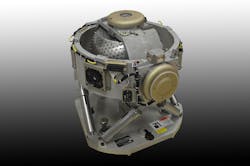Fiber-optic gyro (FOG) technology enhancing accuracy of inertial navigation for surface ships and submarines
CHARLOTTESVILLE, Va. – Inertial guidance experts at Northrop Grumman Corp. are capitalizing on fiber-optic gyroscope technology to enhance the navigational accuracy of U.S. Navy surface warships and submarines where satellite navigation signals are not available.
The Navy's newest maritime navigation system, the AN/WSN-12 uses the latest fiber-optic gyro (FOG) technology to replace decades-old ring laser gyro technology where signals from Global Positioning System (GPS) navigation satellites are blocked, jammed, or otherwise denied.
The newer FOG technology in the WSN-12 navigation system not only helps keep surface ships and submarines on the right courses, but also enhances the accuracy of missiles and other weapons, as well as enables submarines to remain stealthily underwater safely for long periods of time. The WSN-12 FOG comes from the Northrop Grumman Mission Systems segment in Woodland Hills, Calif.
The transition to the WSN-12 is making navigation more accurate," says Rudy Fernandez, site director of the Northrop Grumman Maritime Systems and Integration operating unit in Charlottesville, Va."The inertial navigation system in the WSN-12 is giving a lot more accuracy to our platforms, and keeps the submarine safer because you can stay underwater longer, and can shoot weapons with much more accuracy."
Inertial navigation accuracy especially is important for submarines, which periodically must surface to periscope depth to raise a GPS antenna to get the latest satellite navigation fix to keep the boat's navigation system up to date.
Any gyro -- a FOG, ring-laser, or spinning-mass -- naturally will drift over time, which decreases its reliability if not updated periodically with GPS positioning. "You reset the gyro to a GPS fix, and once you lose GPS, the area of uncertainty of that position over time starts to grow," Fernandez explains.
In other words, the longer a submarine operates submerged only on inertial navigation without a GPS position update, the larger its potential navigational errors. The WSN-7, for example, requires a submarine to come up for a GPS fix about every eight hours, while the WSN-12 can help a submerged submarine operate safely without a GPS update for longer periods of time, Fernandez says.
The WSN-12 is part of an overall surface ship and submarine navigation system upgrade that represents a transition from paper navigational chart maps to an all-electronic system that operates much like a GPS moving map display in a car.
The Northrop Grumman Electronic Chart Display System (ECDIS) takes inputs from GPS fixes, onboard inertial navigation systems, and from other sensors to update moving-map displays on electronic screens rather than using paper charts.
ECDIS "walks you through the entire route on the electronic chart, and will warn you if your route will be anywhere close to an undersea mount or shipwreck," Fernandez says. The Navy approved the Northrop Grumman ECDIS for deployment to ships and submarines last October. It is aboard the aircraft carrier USS Theodore Roosevelt (CVN 71).
Northrop Grumman announced receipt of a Navy contract earlier this month to produce the AN/WSN-12 inertial sensor module (ISM) -- a next-generation sensor that improves maritime navigation in GPS-denied environments for surface ships and submarines.
The Northrop Grumman-built AN/WSN-12 ISM provides maritime positioning data with or without GPS, and is a key component of the U.S. Navy’s AN/WSN-12 Inertial Navigator System (INS), upgrading the Northrop Grumman built AN/WSN-7 INS. The 25-year-old WSN-7 is on nearly every ship in the U.S. Navy and has been the program of record for more than two decades.
The first ISM is expected to be ship tested this year, Northrop Grumman officials say. Northrop Grumman reported completion of the ISM's preliminary design review in May 2016, and critical design review in June 2018.
The ISM will help will provide mission critical ship positioning, velocity, and altitude data to shipboard sensors, combat systems, guns, and missile systems. It will use an open-systems architecture using a modular design, standards-based interfaces, and widely supported consensus-based standards.
For more information contact Northrop Grumman online at www.northropgrumman.com/what-we-do/sea.

John Keller | Editor-in-Chief
John Keller is the Editor-in-Chief, Military & Aerospace Electronics Magazine--provides extensive coverage and analysis of enabling electronics and optoelectronic technologies in military, space and commercial aviation applications. John has been a member of the Military & Aerospace Electronics staff since 1989 and chief editor since 1995.

